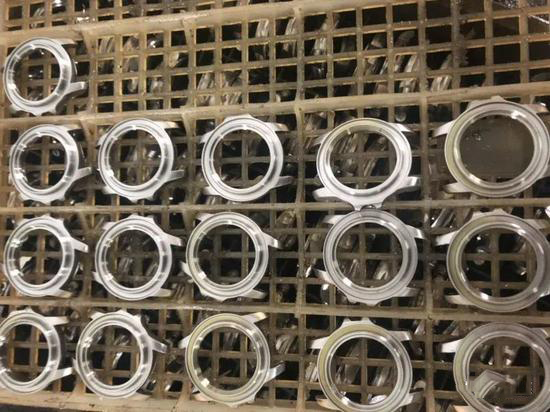A China é a base mais importante do mundo, e existem inúmeros grandes e pequenos fabricantes de relógios no Delta do Rio das Pérolas, e esses fabricantes de relógios upstream, midstream e downstream formam uma enorme e delicada cadeia da indústria relojoeira.
Se o movimento é o núcleo de um relógio, a caixa é o corpo principal do relógio. A aparência da estrutura da caixa e o nível de tecnologia são o reflexo direto da qualidade de um relógio.
De acordo com o material, existem principalmente caixas de liga de zinco, caixas de cobre, caixas de aço e caixas de titânio, e o processo geral de processamento de várias caixas de metal não é muito diferente.
A matéria-prima para a produção de caixas de relógios é a fundição/embrião, e o processo é principalmente: torneamento, fresamento, furação, retificação, etc.
O principal fluxo de processamento de caixas de metal de relógios é o seguinte.
Processamento de fundição de caixa – Torneamento, furação e fresamento – Processamento de superfície (polimento/escovação/jateamento de areia, etc.) – Tratamento de superfície (chapeamento, ataque químico, etc.) – -Montar peças da caixa
Claro, este é apenas um compartilhamento geral do processo de fabricação simples, há muitos detalhes que não foram ditos, para fazer uma boa caixa de relógio não é necessário apenas um processamento meticuloso de cada departamento, a necessidade de cada processo, os trabalhadores qualificados, especialmente o processo de polimento, o efeito de superfície de bom ou ruim, tudo dependendo das mãos do trabalhador.
A caixa do relógio acabada requer as seguintes peças de montagem: corpo, vidro, tampa inferior, moldura, pequenas peças decorativas diversas e parafusos, tampa interna e anel de vedação, i-ring.
Neste artigo, exploraremos o processo de fabricação da caixa do relógio, incluindo o guia de tamanho da caixa do relógio, diâmetro da caixa do relógio e muito mais.
Processo de fabricação de caixas de relógio
Vamos dar uma olhada mais de perto no processo de fabricação da caixa do relógio. O processo de fabricação pode variar dependendo do tipo de caixa de relógio e dos materiais utilizados, mas existem algumas etapas comuns envolvidas na maioria dos processos de fabricação de caixas de relógio.
Você pode ver uma caixa de relógio linda e brilhante. Ainda assim, o ambiente da fábrica de caixas de relógios não é tão bom quanto pensamos.
O processamento de corte requer o uso de óleo, e as mãos de trabalho com óleo e preto, todas são óleo, o polimento de superfície também produzirá poeira, se você entrar na oficina de polimento, com certeza sairá todas as cinzas. Enquanto o bate-papo aleatório termina.
Então, vamos verificar o processo:
Passo 1: Projetar a estrutura da caixa do relógio e os relógios acabados
Os trabalhadores de desenho de relógios são geralmente divididos em desenhista plano (principalmente 2D) e desenhista de efeitos estruturais (3D).
O desenhista primeiro desenha os relógios acabados, geralmente desenho 2D, 3D e desenhos de renderização, para confirmar que os detalhes da aparência não são problema. Forneça desenhos 3D e desenhos de montagem ao projetista da fábrica de caixas, o projetista da fábrica de caixas de relógios desenhará os desenhos de dados estruturais e nosso engenheiro confirmará, se não houver problema, começaremos a fazer.
(Geralmente, faremos o protótipo primeiro e garantiremos que o protótipo esteja OK antes de produzir o pedido em massa)

Desenho 3D

Desenho de montagem

desenho de dados de estrutura
Etapa 2: processar aproximadamente o caso
De acordo com o desenho, a fábrica de embriões faz o molde da caixa (pressione a placa de aço para fora do formato geral do relógio, veja as fotos abaixo, por exemplo)
Em seguida, use a máquina para abrir o áspero, corte a área extra, mas deixe alguma margem (geralmente deixando margem de 0,5mm)
Em seguida, a máquina NC (torno automático) faz o processo de precisão, de acordo com o desenho para usinar o tamanho exato, geralmente, a estrutura interna é diretamente precisa no lugar (geralmente permite uma faixa de tolerância de 3-5c, 1c = 0,01 mm por fio de cerca de 8c).

Máquina CNC
Depois disso, a furadeira faz o furo e os furos da caixa e depois retorna para a máquina retificando a área inferior (deixada no último processamento externo para evitar o colapso) e então faz a próxima etapa de fresamento.


Se o estilo da caixa for diferente, o processamento também será um pouco diferente, o passo acima é uma etapa geral, é necessário usar um torno pequeno e equipamento CNC.
Etapa 3. Polimento da sala de esmerilhamento
A sala de retificação é a mais importante em todo o processo de processamento da caixa, e as etapas acima apenas feitas de acordo com o processo padrão estão ok. Para garantir que a estrutura interna esteja correta, a aparência do polimento fica toda no ofício do retificador.

Passo 4. Sala de inspeção de casos
Depois que as caixas terminam de grelhar, limpe as caixas, elas são enviadas para a sala de inspeção para inspeção de acordo com os requisitos do grau de grelha, e as peças defeituosas são marcadas com caneta vermelha para retificação posterior para garantir que atendam aos requisitos de qualidade.
Etapa 5. Verificação de qualidade
O departamento de qualidade é o principal responsável pela verificação das peças da caixa


Os acessórios da caixa são geralmente: óculos, anel de cerâmica, anel I, anel O (anel I ou anel O é o anel à prova d'água de vidro e tampa inferior), óleo de enchimento ou óleo luminoso, acessórios de hardware (rosca de mola, rosca octagonal, parafusos de relógio), tubo de barra e tampa inferior.
Etapa 6. Armazém
Todos os acessórios da caixa verificam a qualidade sem problemas e estão no armazém, respectivamente, registrados no armazém. O armazém confirma que todos os acessórios chegam e enviam para o departamento de embalagem.
Finalmente embalando
O departamento de embalagem é responsável pela montagem de todas as peças e pela embalagem final
Sobre o guia de tamanho da caixa do relógio
vamos entender o guia de tamanho da caixa do relógio. O tamanho da caixa do relógio é um dos fatores mais importantes na hora de escolher um relógio. Os relógios do tamanho certo não só cabem perfeitamente no seu pulso, mas também têm uma aparência esteticamente agradável. O tamanho da caixa do relógio é medido em milímetros (mm) e é determinado pelo diâmetro da caixa do relógio.
O diâmetro da caixa do relógio é medido de um lado a outro da caixa do relógio, excluindo a coroa. A coroa é o pequeno botão na lateral do relógio usado para acertar a hora. Os tamanhos das caixas dos relógios podem variar de 20 mm a 50 mm ou mais. No entanto, o tamanho de caixa de relógio mais comum para homens está entre 38 mm e 42 mm, enquanto o tamanho de caixa de relógio mais comum para mulheres está entre 26 mm e 38 mm.
O tamanho da caixa do relógio depende, em última análise, da preferência pessoal e do que fica melhor em seu pulso. É importante considerar o tamanho da caixa do relógio, especialmente se você tiver um pulso pequeno ou maior. Um relógio muito grande ou muito pequeno pode ser desconfortável de usar e pode não parecer esteticamente agradável.
Um dos fatores-chave para determinar o tamanho da caixa de um relógio é o movimento do relógio. O movimento do relógio é o mecanismo que alimenta o relógio e determina a sua funcionalidade. Existem diferentes tipos de movimentos de relógio, incluindo quartzo, mecânicos e automáticos. Cada tipo de movimento possui dimensões diferentes, o que pode afetar o tamanho da caixa do relógio.
Por exemplo, os movimentos de quartzo são normalmente menores e mais compactos que os movimentos mecânicos. Como resultado, os relógios com movimentos de quartzo podem ser projetados com caixas menores. Por outro lado, os movimentos mecânicos são maiores e requerem mais espaço, o que significa que os relógios com movimentos mecânicos normalmente têm caixas maiores.
Outro fator que pode influenciar o tamanho da caixa do relógio é o estilo do relógio. Alguns estilos de relógios, como relógios sociais, são projetados para serem finos e elegantes, com caixas menores que cabem perfeitamente no pulso. Outros estilos, como relógios de mergulho, são projetados para serem mais robustos e duráveis, com caixas maiores que podem suportar condições adversas.
Sobre o diâmetro da caixa do relógio
O diâmetro da caixa do relógio é outro fator importante a considerar na fabricação de relógios. O diâmetro é normalmente medido em milímetros e pode variar de 26 mm a 50 mm ou mais. O diâmetro da caixa do relógio pode afetar a aparência geral do relógio, bem como sua funcionalidade.
Por exemplo, relógios com diâmetros de caixa menores são geralmente considerados mais elegantes e refinados. Eles podem ser usados com trajes formais e são adequados para ocasiões em que o estilo discreto é preferido. Os relógios com diâmetros de caixa maiores, por outro lado, são frequentemente associados a um estilo mais desportivo ou casual. Eles podem ser usados com trajes mais casuais e são adequados para atividades ao ar livre.
O diâmetro da caixa do relógio também pode afetar a legibilidade do relógio. Relógios com diâmetros de caixa maiores geralmente têm mostradores e numerais maiores, o que pode torná-los mais fáceis de ler. No entanto, relógios com diâmetros de caixa menores também podem ser projetados com mostradores claros e fáceis de ler, adequados para uso diário.
Agora você tem uma ideia geral de como a caixa do relógio foi feita?

